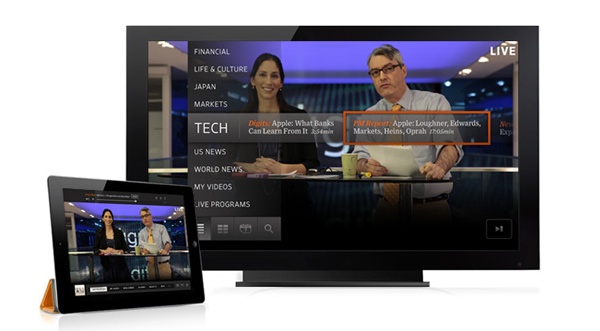
 Editor’s Note: Each week, Ken Doctor — author of Newsonomics and longtime watcher of the business side of digital news — writes about the economics of news for the Lab.
Editor’s Note: Each week, Ken Doctor — author of Newsonomics and longtime watcher of the business side of digital news — writes about the economics of news for the Lab.
It’s news. It’s video. It’s a streaming tablet product that’s this week’s #1 free news app in Apple’s App Store.
And it’s The Wall Street Journal — founded in 1889.
WSJ Live, launched last week, is a milestone product. It’s not Fox News. It’s not CNN. It’s not New York Times news video. WSJ Live is its own thing, and a model for the news industry. Newspaper companies can talk the talk of becoming multimedia companies, but most are still text-bound. WSJ Live is a news video product that does a great job of leveraging the new technologies of the day and converging them to create an easy-on-the-eyes, easy-to-use new consumer product.
Notice, first, that WSJ Live is a tablet product — or more precisely a “lean-back” product, available not only on your iPad or your Galaxy Tab but aiming to get in early on “connected TV” platforms. If you want WSJ news video, you can access it on WSJ.com and on your smartphone. WSJ Live, though, understands that the tablet is today’s go-to platform for this kind of news experience.
It leverages the tablet-sized screen well. It mixes on-the-hour scheduled programming with on-demand access. It balances the talking heads of its global reporting workforce, via Skype, with anchor-hosted programs (News Hub), photo stills, and graphics. It is faster-paced than most news video, with some of the print-reporter geekiness at least acceptable and often enjoyable compared to the slick, no-surprise, Wolf Blitzer-me-to-sleep monotony of cable news. Within the business news world, it sits somewhere between the casualness of American Public Media’s Marketplace and CNBC’s button-down coverage.
Much of the action is set in the combined Journal/Fox/News Corp. building on the Avenue of the Americas in Midtown. The merging print/video setups there are found in few other newsrooms in the world, one of which would have to be El Tiempo, a largely unheralded multimedia leader in Bogota. WSJ Live is touchable in navigation, using the increasingly familiar ribbon (NPR, Pulse, HuffPo Glider) for navigation.
It acts on two of three parts of what I’ve called the Tablet Trifecta — mobile, video, and social. Those three phenomenon, each too often considered separately as audience or revenue categories by news business people, are what makes the tablet a truly phenomenal product. We watch video wherever we are, comfortably, and then with a touch share video with friends and associates. The tablet is a product that is natively viral.
WSJ Live, of course, is a video product on the mobile tablet. For now, it lacks simple social sharing, the little arrow we’ve come to see as standard issue on mobile products. The Journal’s Alan Murray tells me the arrow will soon make its appearance, socializing the product.
As good as it is out of the box, WSJ Live is clearly an evolutionary product. It evolved from the Journal’s fledgling efforts. Consider this: Two years ago, the Journal did not offer any regular live webcasting. “A year ago, we did an hour a day,” says Murray, executive editor for online. Today, the full-time video staff of “fewer than 20,” supports a minimum of 3.5 hours of five-day-a-week programming, comprised of seven 30-minute shows and then chunked into discrete segments.
Today, it is a major business line, with more than seven million video streams served per month (pre-WSJ Live), according to Murray.
That’s a steep ramp, and one still meeting the challenge (the biggest in Murray’s assessment) of “getting the reporting staff trained and comfortable presenting to a camera.” Journalists go through a one-week training course; one’s underway this week.
When we look at the newsonomics of WSJ Live, we see these key factors:
Maybe it’s that freeness that decided the Journal on providing only three text links to its “front page” news stories, and none directly from its videos. Which, if you think about it, is odd. It’s WSJ Live, but in video, with print reporters talking about stories they’ve written or will write — but with few links to the stories. (Rather, anchors often say: “Go to WSJ.com for more.”) If the Journal provided those links, how would it charge for access — paid access that currently generates more than $100 million in digital circulation revenue? That’s TBD.
There are lots of kinks to work out and think through. For instance:
If you run a newspaper company, or a newsroom, WSJ Live should interrupt your reverie that replica tablet products are “enough,” right now. Hell — smarter presentations of text on tablet products, with good still photos, aren’t enough. But WSJ Live says that far better than 10 analyst columns.
If you run a broadcast company, WSJ Live should send a chill down your spine. How did these print guys do moving pictures better than us? Most local broadcast companies are still stuck in the broadcast thinking mode.
While CNN moved early and impressively to real multimedia, its tablet news video experience isn’t near as fluid. NBC’s Nightly News app is good and has Brian Williams to give it personality, but, too, doesn’t compare well. MSNBC is not yet seen on the tablet, other than Rachel Maddow’s show. The uber multi-platform Bloomberg, exploding in reach and in hiring talent, is undoubtedly studying WSJ Live and planning to play catchup.
WSJ Live becomes the sixth WSJ iPad-specific apps, with one additional Barrons and two Marketwatch (one paid, its data app) products. What began not long ago as an experiment in tablet products is becoming serious business.